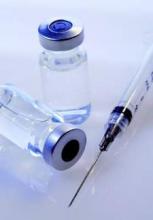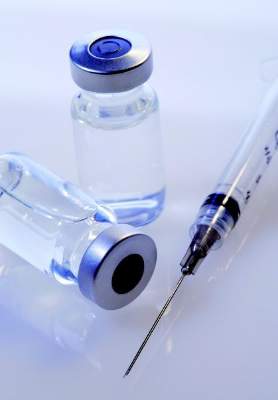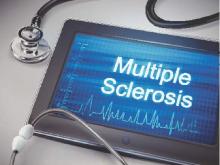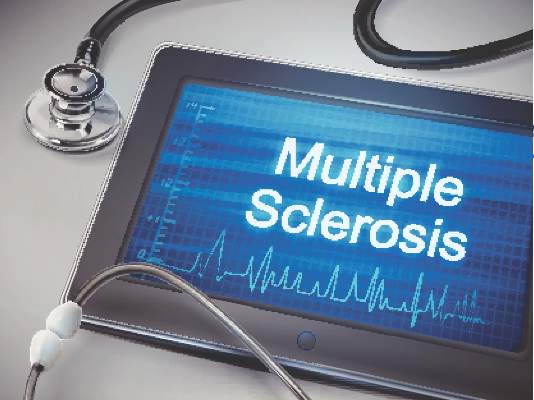User login
As adults age, odds of discussing memory problems with doctors decline
Few adults who reported subjective memory complaints discussed such issues with a health care provider, a study conducted by telephone involving more than 10,276 people shows.
Just under a quarter (22.9%) of the respondents reported discussing their memory problems with a health care professional. Even those who reported having a routine check-up within a year of the date they were surveyed were only sightly more likely to discuss their memory problem with a health care professional, compared with those who had not seen a doctor within the past year. Specifically, 25.2% of those in the former group reported taking such an action, reported Mary L. Adams of On Target Health Data.
The respondents were aged 45 years or older and lived in 21 states. Those who reported subjective memory complaints were more likely to live in California and identify as Hispanic. They also were more likely to be aged 75 or older and currently smoke than respondents not reporting subjective memory complaints.
Respondents with functional difficulties were significantly more likely to have engaged in a conversation about their memory issues with a health care professional than those who had not reported functional difficulties, with 34.4% of the former group having discussed their memory problems with a health care professional. A similar percentage of survey respondents who had been diagnosed with depression reported having talked to a health care professional about memory problems (33.2%).
Among the respondents who said memory complaints interfere with working, volunteering, or engaging in social activities sometimes, usually, or always, the rates were 33.8%, 38.9%, and 51.3%, respectively. Another study finding was that as age increased, the likelihood of discussing memory problems with a health care professional decreased.
The study findings suggest that “routine check-ups are a missed opportunity for assessing and discussing memory problems for the majority of adults aged 45 or older with [subjective memory problems],” Ms. Adams wrote. The results “highlight the need for the cognitive assessment required in the Affordable Care Act for Medicare recipients, and also suggest the need and potential benefit of cognitive assessment among adults younger than 65.”
Read the study in Preventing Chronic Disease (2016 Jan 28. doi: 10.5888/pcd13.150471).
Few adults who reported subjective memory complaints discussed such issues with a health care provider, a study conducted by telephone involving more than 10,276 people shows.
Just under a quarter (22.9%) of the respondents reported discussing their memory problems with a health care professional. Even those who reported having a routine check-up within a year of the date they were surveyed were only sightly more likely to discuss their memory problem with a health care professional, compared with those who had not seen a doctor within the past year. Specifically, 25.2% of those in the former group reported taking such an action, reported Mary L. Adams of On Target Health Data.
The respondents were aged 45 years or older and lived in 21 states. Those who reported subjective memory complaints were more likely to live in California and identify as Hispanic. They also were more likely to be aged 75 or older and currently smoke than respondents not reporting subjective memory complaints.
Respondents with functional difficulties were significantly more likely to have engaged in a conversation about their memory issues with a health care professional than those who had not reported functional difficulties, with 34.4% of the former group having discussed their memory problems with a health care professional. A similar percentage of survey respondents who had been diagnosed with depression reported having talked to a health care professional about memory problems (33.2%).
Among the respondents who said memory complaints interfere with working, volunteering, or engaging in social activities sometimes, usually, or always, the rates were 33.8%, 38.9%, and 51.3%, respectively. Another study finding was that as age increased, the likelihood of discussing memory problems with a health care professional decreased.
The study findings suggest that “routine check-ups are a missed opportunity for assessing and discussing memory problems for the majority of adults aged 45 or older with [subjective memory problems],” Ms. Adams wrote. The results “highlight the need for the cognitive assessment required in the Affordable Care Act for Medicare recipients, and also suggest the need and potential benefit of cognitive assessment among adults younger than 65.”
Read the study in Preventing Chronic Disease (2016 Jan 28. doi: 10.5888/pcd13.150471).
Few adults who reported subjective memory complaints discussed such issues with a health care provider, a study conducted by telephone involving more than 10,276 people shows.
Just under a quarter (22.9%) of the respondents reported discussing their memory problems with a health care professional. Even those who reported having a routine check-up within a year of the date they were surveyed were only sightly more likely to discuss their memory problem with a health care professional, compared with those who had not seen a doctor within the past year. Specifically, 25.2% of those in the former group reported taking such an action, reported Mary L. Adams of On Target Health Data.
The respondents were aged 45 years or older and lived in 21 states. Those who reported subjective memory complaints were more likely to live in California and identify as Hispanic. They also were more likely to be aged 75 or older and currently smoke than respondents not reporting subjective memory complaints.
Respondents with functional difficulties were significantly more likely to have engaged in a conversation about their memory issues with a health care professional than those who had not reported functional difficulties, with 34.4% of the former group having discussed their memory problems with a health care professional. A similar percentage of survey respondents who had been diagnosed with depression reported having talked to a health care professional about memory problems (33.2%).
Among the respondents who said memory complaints interfere with working, volunteering, or engaging in social activities sometimes, usually, or always, the rates were 33.8%, 38.9%, and 51.3%, respectively. Another study finding was that as age increased, the likelihood of discussing memory problems with a health care professional decreased.
The study findings suggest that “routine check-ups are a missed opportunity for assessing and discussing memory problems for the majority of adults aged 45 or older with [subjective memory problems],” Ms. Adams wrote. The results “highlight the need for the cognitive assessment required in the Affordable Care Act for Medicare recipients, and also suggest the need and potential benefit of cognitive assessment among adults younger than 65.”
Read the study in Preventing Chronic Disease (2016 Jan 28. doi: 10.5888/pcd13.150471).
FROM PREVENTING CHRONIC DISEASE
ECT seems to be effective treatment for major depression in elderly
A long recovery from disorientation following electroconvulsive therapy (ECT) seems to be a sign that the therapy has effectively treated an elderly patient with major depression, suggests a longitudinal cohort study conducted in Norway.
The study comprised 57 Norwegian-speaking inpatients, aged 60-85 years, who had major depressive disorders. To enter the study, a patient needed to have a minimum baseline score of 18 on the 17-item Hamilton Rating Scale for Depression (HRSD17). Among the study’s exclusion criteria were a diagnosis of dementia, Parkinson’s disease, schizophrenia, or schizoaffective disorder, and any use of ECT during the previous 6 months. All study participants received the seizure-inducing ECT twice a week. The intensity of therapy varied per patient and session, with age and sex of a patient having been among the criteria used to determine the intensity of each stimulus administered. Treatments continued until a patient achieved remission or the patient’s benefits plateaued. The maximum number of sessions was 16.
Two assessors used the questions included in the HRSD17 to assess the decline in depression symptom severity for each patient every Wednesday between every second ECT session. A patient who achieved an HRSD17 score of 7 or less was considered to be in remission. The patient’s postictal reorientation time (PRT) following ECT therapy was recorded at the first and third treatments. “Assessments of the PRTs were timed relative to the assessments of depressive symptoms during the ECT course. Hence, the PRT at the third treatment was recorded 2 days after the second assessment of symptom severity,” wrote Tor Magne Bj<scaps>ø</scaps>lseth and colleagues. The PRT was defined as the minutes that passed until the patients were able to correctly answer four of five questions about themselves, their location, and the time. A maximum PRT score of 50 minutes was assigned to any patient who took more than 40 minutes to recover from disorientation.
While the researchers did not see a significant association between the mean PRT and the outcome of ECT, they observed that the patients with longer PRTs during early ECT sessions were likely to experience greater declines in depression symptoms.
The researchers also found that “a greater increment in [ECT] dosage rendered a smaller absolute and relative decline in PRT.”
An additional finding suggesting that ECT is beneficial for elderly patients with major depressive disorder was that the study participants’ HRSD17 scores on average declined by 14.7 points from baseline to the end of their ECT sessions.
“Our results indicate that a longer PRT reflects a more efficacious seizure and that the speed of recovery from disorientation may supplement [electroencephalogram] characteristics in tailoring stimulus dosing for elderly patients, at least early in the treatment course of formula-based ECT. It remains to be established whether our findings are generalizable beyond the elderly population and beyond formula-based methods. Further research is also warranted to clarify how the PRT may be utilized to guide stimulus dosing,” the researchers wrote.
Read the study in Journal of Affective Disorders (doi: 10.1016/j.jad.2015.10.013).
A long recovery from disorientation following electroconvulsive therapy (ECT) seems to be a sign that the therapy has effectively treated an elderly patient with major depression, suggests a longitudinal cohort study conducted in Norway.
The study comprised 57 Norwegian-speaking inpatients, aged 60-85 years, who had major depressive disorders. To enter the study, a patient needed to have a minimum baseline score of 18 on the 17-item Hamilton Rating Scale for Depression (HRSD17). Among the study’s exclusion criteria were a diagnosis of dementia, Parkinson’s disease, schizophrenia, or schizoaffective disorder, and any use of ECT during the previous 6 months. All study participants received the seizure-inducing ECT twice a week. The intensity of therapy varied per patient and session, with age and sex of a patient having been among the criteria used to determine the intensity of each stimulus administered. Treatments continued until a patient achieved remission or the patient’s benefits plateaued. The maximum number of sessions was 16.
Two assessors used the questions included in the HRSD17 to assess the decline in depression symptom severity for each patient every Wednesday between every second ECT session. A patient who achieved an HRSD17 score of 7 or less was considered to be in remission. The patient’s postictal reorientation time (PRT) following ECT therapy was recorded at the first and third treatments. “Assessments of the PRTs were timed relative to the assessments of depressive symptoms during the ECT course. Hence, the PRT at the third treatment was recorded 2 days after the second assessment of symptom severity,” wrote Tor Magne Bj<scaps>ø</scaps>lseth and colleagues. The PRT was defined as the minutes that passed until the patients were able to correctly answer four of five questions about themselves, their location, and the time. A maximum PRT score of 50 minutes was assigned to any patient who took more than 40 minutes to recover from disorientation.
While the researchers did not see a significant association between the mean PRT and the outcome of ECT, they observed that the patients with longer PRTs during early ECT sessions were likely to experience greater declines in depression symptoms.
The researchers also found that “a greater increment in [ECT] dosage rendered a smaller absolute and relative decline in PRT.”
An additional finding suggesting that ECT is beneficial for elderly patients with major depressive disorder was that the study participants’ HRSD17 scores on average declined by 14.7 points from baseline to the end of their ECT sessions.
“Our results indicate that a longer PRT reflects a more efficacious seizure and that the speed of recovery from disorientation may supplement [electroencephalogram] characteristics in tailoring stimulus dosing for elderly patients, at least early in the treatment course of formula-based ECT. It remains to be established whether our findings are generalizable beyond the elderly population and beyond formula-based methods. Further research is also warranted to clarify how the PRT may be utilized to guide stimulus dosing,” the researchers wrote.
Read the study in Journal of Affective Disorders (doi: 10.1016/j.jad.2015.10.013).
A long recovery from disorientation following electroconvulsive therapy (ECT) seems to be a sign that the therapy has effectively treated an elderly patient with major depression, suggests a longitudinal cohort study conducted in Norway.
The study comprised 57 Norwegian-speaking inpatients, aged 60-85 years, who had major depressive disorders. To enter the study, a patient needed to have a minimum baseline score of 18 on the 17-item Hamilton Rating Scale for Depression (HRSD17). Among the study’s exclusion criteria were a diagnosis of dementia, Parkinson’s disease, schizophrenia, or schizoaffective disorder, and any use of ECT during the previous 6 months. All study participants received the seizure-inducing ECT twice a week. The intensity of therapy varied per patient and session, with age and sex of a patient having been among the criteria used to determine the intensity of each stimulus administered. Treatments continued until a patient achieved remission or the patient’s benefits plateaued. The maximum number of sessions was 16.
Two assessors used the questions included in the HRSD17 to assess the decline in depression symptom severity for each patient every Wednesday between every second ECT session. A patient who achieved an HRSD17 score of 7 or less was considered to be in remission. The patient’s postictal reorientation time (PRT) following ECT therapy was recorded at the first and third treatments. “Assessments of the PRTs were timed relative to the assessments of depressive symptoms during the ECT course. Hence, the PRT at the third treatment was recorded 2 days after the second assessment of symptom severity,” wrote Tor Magne Bj<scaps>ø</scaps>lseth and colleagues. The PRT was defined as the minutes that passed until the patients were able to correctly answer four of five questions about themselves, their location, and the time. A maximum PRT score of 50 minutes was assigned to any patient who took more than 40 minutes to recover from disorientation.
While the researchers did not see a significant association between the mean PRT and the outcome of ECT, they observed that the patients with longer PRTs during early ECT sessions were likely to experience greater declines in depression symptoms.
The researchers also found that “a greater increment in [ECT] dosage rendered a smaller absolute and relative decline in PRT.”
An additional finding suggesting that ECT is beneficial for elderly patients with major depressive disorder was that the study participants’ HRSD17 scores on average declined by 14.7 points from baseline to the end of their ECT sessions.
“Our results indicate that a longer PRT reflects a more efficacious seizure and that the speed of recovery from disorientation may supplement [electroencephalogram] characteristics in tailoring stimulus dosing for elderly patients, at least early in the treatment course of formula-based ECT. It remains to be established whether our findings are generalizable beyond the elderly population and beyond formula-based methods. Further research is also warranted to clarify how the PRT may be utilized to guide stimulus dosing,” the researchers wrote.
Read the study in Journal of Affective Disorders (doi: 10.1016/j.jad.2015.10.013).
FROM JOURNAL OF AFFECTIVE DISORDERS
Migraines more severe in PNES patients than in epilepsy patients
Psychogenic nonepileptic seizure (PNES) patients reported having more frequent and longer-lasting migraines than patients diagnosed with epilepsy, in an observational study conducted in the United States.
Researchers questioned 29 patients with epilepsy and 43 PNES patients about their migraines and seizures through the use of standardized questionnaires and a standardized interview. All study participants were found in a clinician database of patients who had been evaluated in the Mayo Clinic epilepsy monitoring unit between 2008 and 2014. Their ages ranged from 20 years to 82 years. Patients who were diagnosed with both PNES and epilepsy were excluded from the research project.
PNES patients reported having significantly more migraine attacks and longer-duration migraines (when untreated) than patients with epilepsy. Specifically, on average, PNES patients said they experienced 6.5 migraine attacks per month and migraines with a length of 39.5 hours, whereas patients with epilepsy said they had, on average, 3.8 migraine attacks per month and migraines lasting 27.3 hours. Another significant difference between the two groups of patients occurred in the numbers of nonvisual migraine aura symptoms reported. While 22 of the PNES patients (78.6%) reported experiencing such symptoms, 7 of the epilepsy patients (46.7%) reported having nonvisual aura symptoms (P = .033).
“Our study adds to the existing literature [on the relationship between PNES and migraine] by detailing specific migraine characteristics in patients with PNES,” wrote Morgan A. Shepard and colleagues. The researchers noted that PNES patients could have overreported the severity of their migraine symptoms and that a high level of somatization has been found in patients with PNES.
The results of this research project “justify the need for clinicians to assess PNES patients for the presence of migraine and when present, to treat them appropriately for migraine,” according to the researchers.
The study’s authors did not report any conflicts of interest.
Read the study in Seizure (doi: 10.1016/j.seizure.2015.12.006).
Psychogenic nonepileptic seizure (PNES) patients reported having more frequent and longer-lasting migraines than patients diagnosed with epilepsy, in an observational study conducted in the United States.
Researchers questioned 29 patients with epilepsy and 43 PNES patients about their migraines and seizures through the use of standardized questionnaires and a standardized interview. All study participants were found in a clinician database of patients who had been evaluated in the Mayo Clinic epilepsy monitoring unit between 2008 and 2014. Their ages ranged from 20 years to 82 years. Patients who were diagnosed with both PNES and epilepsy were excluded from the research project.
PNES patients reported having significantly more migraine attacks and longer-duration migraines (when untreated) than patients with epilepsy. Specifically, on average, PNES patients said they experienced 6.5 migraine attacks per month and migraines with a length of 39.5 hours, whereas patients with epilepsy said they had, on average, 3.8 migraine attacks per month and migraines lasting 27.3 hours. Another significant difference between the two groups of patients occurred in the numbers of nonvisual migraine aura symptoms reported. While 22 of the PNES patients (78.6%) reported experiencing such symptoms, 7 of the epilepsy patients (46.7%) reported having nonvisual aura symptoms (P = .033).
“Our study adds to the existing literature [on the relationship between PNES and migraine] by detailing specific migraine characteristics in patients with PNES,” wrote Morgan A. Shepard and colleagues. The researchers noted that PNES patients could have overreported the severity of their migraine symptoms and that a high level of somatization has been found in patients with PNES.
The results of this research project “justify the need for clinicians to assess PNES patients for the presence of migraine and when present, to treat them appropriately for migraine,” according to the researchers.
The study’s authors did not report any conflicts of interest.
Read the study in Seizure (doi: 10.1016/j.seizure.2015.12.006).
Psychogenic nonepileptic seizure (PNES) patients reported having more frequent and longer-lasting migraines than patients diagnosed with epilepsy, in an observational study conducted in the United States.
Researchers questioned 29 patients with epilepsy and 43 PNES patients about their migraines and seizures through the use of standardized questionnaires and a standardized interview. All study participants were found in a clinician database of patients who had been evaluated in the Mayo Clinic epilepsy monitoring unit between 2008 and 2014. Their ages ranged from 20 years to 82 years. Patients who were diagnosed with both PNES and epilepsy were excluded from the research project.
PNES patients reported having significantly more migraine attacks and longer-duration migraines (when untreated) than patients with epilepsy. Specifically, on average, PNES patients said they experienced 6.5 migraine attacks per month and migraines with a length of 39.5 hours, whereas patients with epilepsy said they had, on average, 3.8 migraine attacks per month and migraines lasting 27.3 hours. Another significant difference between the two groups of patients occurred in the numbers of nonvisual migraine aura symptoms reported. While 22 of the PNES patients (78.6%) reported experiencing such symptoms, 7 of the epilepsy patients (46.7%) reported having nonvisual aura symptoms (P = .033).
“Our study adds to the existing literature [on the relationship between PNES and migraine] by detailing specific migraine characteristics in patients with PNES,” wrote Morgan A. Shepard and colleagues. The researchers noted that PNES patients could have overreported the severity of their migraine symptoms and that a high level of somatization has been found in patients with PNES.
The results of this research project “justify the need for clinicians to assess PNES patients for the presence of migraine and when present, to treat them appropriately for migraine,” according to the researchers.
The study’s authors did not report any conflicts of interest.
Read the study in Seizure (doi: 10.1016/j.seizure.2015.12.006).
FROM SEIZURE
FDA approves new biomaterial for hernia repair
The Food and Drug Administration has granted 510K clearance to Gore Medical for a new biomaterial for hernia repair, according to a Gore statement.
Gore describes the product – GORE SYNECOR Biomaterial – as having a “unique structure,” which prevents surgeons from having to choose between using a “permanent material” and an “absorbable, nonpermanent material” when deciding which biomaterial to use for a hernia repair.
GORE SYNECOR Biomaterial is composed of the following:
• Dense monofilament polytetrafluoroethylene macroporous knit.
• GORE BIO-A Web, “a tissue scaffold with proven outcomes in contaminated hernia repair. providing rapid vascularization and ingrowth in complex repairs.”
• Nonporous PGA/TMC film.
No precertification is required for surgeons to implant GORE SYNECOR Biomaterial.
For more information about the new product, visit www.goremedical.com.
The Food and Drug Administration has granted 510K clearance to Gore Medical for a new biomaterial for hernia repair, according to a Gore statement.
Gore describes the product – GORE SYNECOR Biomaterial – as having a “unique structure,” which prevents surgeons from having to choose between using a “permanent material” and an “absorbable, nonpermanent material” when deciding which biomaterial to use for a hernia repair.
GORE SYNECOR Biomaterial is composed of the following:
• Dense monofilament polytetrafluoroethylene macroporous knit.
• GORE BIO-A Web, “a tissue scaffold with proven outcomes in contaminated hernia repair. providing rapid vascularization and ingrowth in complex repairs.”
• Nonporous PGA/TMC film.
No precertification is required for surgeons to implant GORE SYNECOR Biomaterial.
For more information about the new product, visit www.goremedical.com.
The Food and Drug Administration has granted 510K clearance to Gore Medical for a new biomaterial for hernia repair, according to a Gore statement.
Gore describes the product – GORE SYNECOR Biomaterial – as having a “unique structure,” which prevents surgeons from having to choose between using a “permanent material” and an “absorbable, nonpermanent material” when deciding which biomaterial to use for a hernia repair.
GORE SYNECOR Biomaterial is composed of the following:
• Dense monofilament polytetrafluoroethylene macroporous knit.
• GORE BIO-A Web, “a tissue scaffold with proven outcomes in contaminated hernia repair. providing rapid vascularization and ingrowth in complex repairs.”
• Nonporous PGA/TMC film.
No precertification is required for surgeons to implant GORE SYNECOR Biomaterial.
For more information about the new product, visit www.goremedical.com.
Single and double dose of MenACWY-CRM series are immunogenic
Both single-dose and two-dose meningococcal CRM-conjugate vaccine series (MenACWY-CRM) were immunogenic, but antibody responses were greater in patients after two doses, especially for patients aged 2-5 years old, according to a new study.
The multicenter, randomized, observer-blind, placebo-controlled study, conducted in the United States between October 2012 and May 2014, included 713 subjects who were up to date with their routine childhood immunizations. The subjects were broken into two age groups: children aged 2-5 years and children aged 6-10 years. The two age groups were randomized 1:1 to receive two doses of MenACWY-CRM or one dose of placebo followed by one dose of MenACWY-CRM, 2 months apart. Immunogenicity was measured using serum bactericidal activity with human complement.
The researchers’ primary objective was to assess the noninferiority and superiority of antibody responses of the two doses, compared with the single dose against Neisseria meningitidis serogroups A,C, W, and Y, at 1-month after the last vaccination. Among the exclusion criteria for participation in the study were previous or suspected disease caused by N. meningitidis or immunization with any investigational or licensed vaccines containing meningococcal antigens.
Noninferiority of two doses of MenACWY-CRM, compared with a single dose, was demonstrated for all four serogroups. Additionally, at 1 month after the last vaccination, the superiority of receiving the two doses over the single dose was demonstrated for serogroups C and Y, for patients in the 2- to 5-year-old age cohort, while the superiority of two doses over one dose was demonstrated for the serogroup Y, for patients in the 6- to 10-year-old cohort.
The safety profile of the vaccine was similar in both groups. Medically attended adverse events that were considered to have been “possibly or probably related to the study vaccine” occurred in five subjects (as six events) in the 2- to 5-year-old age cohort and three subjects (as three events) in the 6- to 10-year-age cohort. One subject in the cohort aged 6-10 years withdrew from the study, because of vomiting and diarrhea, “which were considered to be unrelated to the study vaccine.” Eight serious adverse events were reported by five subjects, with one of the events “considered to be possibly related to the study vaccine.” That event was idiopathic thrombocytopenia, which occurred in a 6-year-old who received the single dose.
“[B]oth the single-dose and the two-dose primary series of MenACWY-CRM are immunogenic and have an acceptable safety profile in 2- to 10-year-old children. The two-dose primary series induced a higher immune response than [did] a single dose, although this difference in response decreases over time,” Dr. William Johnston Jr. of Alabama Clinical Therapeutics in Birmingham and his colleagues said.
Read the study in the Pediatric Infectious Disease Journal (doi: 10.1097/INF.0000000000000931).
Both single-dose and two-dose meningococcal CRM-conjugate vaccine series (MenACWY-CRM) were immunogenic, but antibody responses were greater in patients after two doses, especially for patients aged 2-5 years old, according to a new study.
The multicenter, randomized, observer-blind, placebo-controlled study, conducted in the United States between October 2012 and May 2014, included 713 subjects who were up to date with their routine childhood immunizations. The subjects were broken into two age groups: children aged 2-5 years and children aged 6-10 years. The two age groups were randomized 1:1 to receive two doses of MenACWY-CRM or one dose of placebo followed by one dose of MenACWY-CRM, 2 months apart. Immunogenicity was measured using serum bactericidal activity with human complement.
The researchers’ primary objective was to assess the noninferiority and superiority of antibody responses of the two doses, compared with the single dose against Neisseria meningitidis serogroups A,C, W, and Y, at 1-month after the last vaccination. Among the exclusion criteria for participation in the study were previous or suspected disease caused by N. meningitidis or immunization with any investigational or licensed vaccines containing meningococcal antigens.
Noninferiority of two doses of MenACWY-CRM, compared with a single dose, was demonstrated for all four serogroups. Additionally, at 1 month after the last vaccination, the superiority of receiving the two doses over the single dose was demonstrated for serogroups C and Y, for patients in the 2- to 5-year-old age cohort, while the superiority of two doses over one dose was demonstrated for the serogroup Y, for patients in the 6- to 10-year-old cohort.
The safety profile of the vaccine was similar in both groups. Medically attended adverse events that were considered to have been “possibly or probably related to the study vaccine” occurred in five subjects (as six events) in the 2- to 5-year-old age cohort and three subjects (as three events) in the 6- to 10-year-age cohort. One subject in the cohort aged 6-10 years withdrew from the study, because of vomiting and diarrhea, “which were considered to be unrelated to the study vaccine.” Eight serious adverse events were reported by five subjects, with one of the events “considered to be possibly related to the study vaccine.” That event was idiopathic thrombocytopenia, which occurred in a 6-year-old who received the single dose.
“[B]oth the single-dose and the two-dose primary series of MenACWY-CRM are immunogenic and have an acceptable safety profile in 2- to 10-year-old children. The two-dose primary series induced a higher immune response than [did] a single dose, although this difference in response decreases over time,” Dr. William Johnston Jr. of Alabama Clinical Therapeutics in Birmingham and his colleagues said.
Read the study in the Pediatric Infectious Disease Journal (doi: 10.1097/INF.0000000000000931).
Both single-dose and two-dose meningococcal CRM-conjugate vaccine series (MenACWY-CRM) were immunogenic, but antibody responses were greater in patients after two doses, especially for patients aged 2-5 years old, according to a new study.
The multicenter, randomized, observer-blind, placebo-controlled study, conducted in the United States between October 2012 and May 2014, included 713 subjects who were up to date with their routine childhood immunizations. The subjects were broken into two age groups: children aged 2-5 years and children aged 6-10 years. The two age groups were randomized 1:1 to receive two doses of MenACWY-CRM or one dose of placebo followed by one dose of MenACWY-CRM, 2 months apart. Immunogenicity was measured using serum bactericidal activity with human complement.
The researchers’ primary objective was to assess the noninferiority and superiority of antibody responses of the two doses, compared with the single dose against Neisseria meningitidis serogroups A,C, W, and Y, at 1-month after the last vaccination. Among the exclusion criteria for participation in the study were previous or suspected disease caused by N. meningitidis or immunization with any investigational or licensed vaccines containing meningococcal antigens.
Noninferiority of two doses of MenACWY-CRM, compared with a single dose, was demonstrated for all four serogroups. Additionally, at 1 month after the last vaccination, the superiority of receiving the two doses over the single dose was demonstrated for serogroups C and Y, for patients in the 2- to 5-year-old age cohort, while the superiority of two doses over one dose was demonstrated for the serogroup Y, for patients in the 6- to 10-year-old cohort.
The safety profile of the vaccine was similar in both groups. Medically attended adverse events that were considered to have been “possibly or probably related to the study vaccine” occurred in five subjects (as six events) in the 2- to 5-year-old age cohort and three subjects (as three events) in the 6- to 10-year-age cohort. One subject in the cohort aged 6-10 years withdrew from the study, because of vomiting and diarrhea, “which were considered to be unrelated to the study vaccine.” Eight serious adverse events were reported by five subjects, with one of the events “considered to be possibly related to the study vaccine.” That event was idiopathic thrombocytopenia, which occurred in a 6-year-old who received the single dose.
“[B]oth the single-dose and the two-dose primary series of MenACWY-CRM are immunogenic and have an acceptable safety profile in 2- to 10-year-old children. The two-dose primary series induced a higher immune response than [did] a single dose, although this difference in response decreases over time,” Dr. William Johnston Jr. of Alabama Clinical Therapeutics in Birmingham and his colleagues said.
Read the study in the Pediatric Infectious Disease Journal (doi: 10.1097/INF.0000000000000931).
FROM THE PEDIATRIC INFECTIOUS DISEASE JOURNAL
Swapping saturated fat and refined carbs for healthy fats could ease global CHD burden
Insufficient omega-6 polyunsaturated fatty acids (n-6 PUFA), excess trans fat and, to a lesser extent, excess saturated fat, are significant causes of coronary heart disease, suggests a global study published online Jan. 20.
“Our analysis provides, for the first time, a rigorous comparison of global CHD burdens attributable to insufficient n-6 PUFA versus higher saturated fat. In 80% of nations, n-6 PUFA–attributable CHD burdens were at least twofold higher than saturated fat–attributable burdens. This suggests that focus on increasing healthful n-6 rich vegetable oils may provide important public health benefits,” Qianyi Wang, Sc.D., and her colleagues said.
The researchers estimated national intakes of saturated fat, n-6 PUFA, and trans fat based on country-specific dietary surveys, food availability data, and for trans fat, industry reports on fats/oils and packaged foods. The effects of dietary fats on CHD mortality were derived from meta-analyses of prospective cohorts, and CHD mortality rates were derived from the 2010 Global Burden of Diseases Study. Absolute and proportional attributable CHD mortality were computed using a comparative risk assessment framework.
The researchers estimated insufficient n-6 PUFA consumption having been replaced by carbohydrate or saturated fat consumption was responsible for 711,800 CHD deaths per year, accounting for 10% of total global CHD mortality and for 187 CHD deaths per year per 1 million adults. The most absolute CHD deaths per year – 547 per 1 million adults – attributable to insufficient n-6 PUFA occurred in Eastern Europe, while Oceania had the highest proportion of n-6 PUFA–attributable CHD deaths. East Asia had both the fewest absolute – 74 per 1 million adults – and lowest proportion – 6.7% – of CHD deaths attributable to inadequate consumption of n-6 PUFA.
Excess consumption of saturated fat as a replacement for n-6 PUFA caused an estimated 250,900 CHD deaths per year, accounting for 3.6% of CHD deaths and 66 CHD deaths per year per 1 million adults.
The researchers estimated that excess trans fat consumption caused 537,200 CHD deaths per year, representing 7.7% of global CHD mortality and 141 CHD deaths per year per 1 million adults. High-income nations generally had higher trans fat–attributable CHD mortality than lower-income nations. The highest trans fat–attributable absolute CHD mortality occurred in Egypt, with 1,120 deaths per year per 1 million adults. Canada, Pakistan, and the United States all had more than 475 deaths per year per 1 million adults because of excess consumption of trans fat. Such deaths accounted for more than 17% of corresponding national CHD mortality.
Sub-Saharan Africa and the Caribbean had the lowest estimated trans fat–attributable CHD mortality, with excess consumption of trans fat accounting for less than 5% of CHD deaths in these regions.
Additional findings of this study included mean global changes in dietary intakes of saturated fat, n-6 PUFA, and trans fat, and corresponding changes in CHD deaths occurring between 1990 and 2010. Specifically, global proportional CHD mortality attributable to insufficient n-6 PUFA and higher saturated fat consumption decreased by 9% and 21%, respectively. Such decreases occurred in concert with a 0.5% increase in consumption of n-6 PUFA and a 0.2% decrease in consumption of saturated fat. In high-income countries, trans fat consumption declined in parallel with policy strategies to reduce industrial trans fat production. In contrast, global proportional CHD deaths attributable to higher trans fat increased by 4% as global mean dietary intakes of trans fat increased by 0.1%.
“Growing evidence indicates that lowering saturated fat provides convincing cardiovascular benefits only when replaced by PUFA, whereas cardiovascular benefits of n-6 PUFA are similar whether replacing saturated fat or total carbohydrates,” said Dr. Wang of the Harvard T.H. Chan School of Public Health, Boston.
Read the study in the Journal of the American Heart Association (doi: 10.1161/JAHA.115.002891).
Insufficient omega-6 polyunsaturated fatty acids (n-6 PUFA), excess trans fat and, to a lesser extent, excess saturated fat, are significant causes of coronary heart disease, suggests a global study published online Jan. 20.
“Our analysis provides, for the first time, a rigorous comparison of global CHD burdens attributable to insufficient n-6 PUFA versus higher saturated fat. In 80% of nations, n-6 PUFA–attributable CHD burdens were at least twofold higher than saturated fat–attributable burdens. This suggests that focus on increasing healthful n-6 rich vegetable oils may provide important public health benefits,” Qianyi Wang, Sc.D., and her colleagues said.
The researchers estimated national intakes of saturated fat, n-6 PUFA, and trans fat based on country-specific dietary surveys, food availability data, and for trans fat, industry reports on fats/oils and packaged foods. The effects of dietary fats on CHD mortality were derived from meta-analyses of prospective cohorts, and CHD mortality rates were derived from the 2010 Global Burden of Diseases Study. Absolute and proportional attributable CHD mortality were computed using a comparative risk assessment framework.
The researchers estimated insufficient n-6 PUFA consumption having been replaced by carbohydrate or saturated fat consumption was responsible for 711,800 CHD deaths per year, accounting for 10% of total global CHD mortality and for 187 CHD deaths per year per 1 million adults. The most absolute CHD deaths per year – 547 per 1 million adults – attributable to insufficient n-6 PUFA occurred in Eastern Europe, while Oceania had the highest proportion of n-6 PUFA–attributable CHD deaths. East Asia had both the fewest absolute – 74 per 1 million adults – and lowest proportion – 6.7% – of CHD deaths attributable to inadequate consumption of n-6 PUFA.
Excess consumption of saturated fat as a replacement for n-6 PUFA caused an estimated 250,900 CHD deaths per year, accounting for 3.6% of CHD deaths and 66 CHD deaths per year per 1 million adults.
The researchers estimated that excess trans fat consumption caused 537,200 CHD deaths per year, representing 7.7% of global CHD mortality and 141 CHD deaths per year per 1 million adults. High-income nations generally had higher trans fat–attributable CHD mortality than lower-income nations. The highest trans fat–attributable absolute CHD mortality occurred in Egypt, with 1,120 deaths per year per 1 million adults. Canada, Pakistan, and the United States all had more than 475 deaths per year per 1 million adults because of excess consumption of trans fat. Such deaths accounted for more than 17% of corresponding national CHD mortality.
Sub-Saharan Africa and the Caribbean had the lowest estimated trans fat–attributable CHD mortality, with excess consumption of trans fat accounting for less than 5% of CHD deaths in these regions.
Additional findings of this study included mean global changes in dietary intakes of saturated fat, n-6 PUFA, and trans fat, and corresponding changes in CHD deaths occurring between 1990 and 2010. Specifically, global proportional CHD mortality attributable to insufficient n-6 PUFA and higher saturated fat consumption decreased by 9% and 21%, respectively. Such decreases occurred in concert with a 0.5% increase in consumption of n-6 PUFA and a 0.2% decrease in consumption of saturated fat. In high-income countries, trans fat consumption declined in parallel with policy strategies to reduce industrial trans fat production. In contrast, global proportional CHD deaths attributable to higher trans fat increased by 4% as global mean dietary intakes of trans fat increased by 0.1%.
“Growing evidence indicates that lowering saturated fat provides convincing cardiovascular benefits only when replaced by PUFA, whereas cardiovascular benefits of n-6 PUFA are similar whether replacing saturated fat or total carbohydrates,” said Dr. Wang of the Harvard T.H. Chan School of Public Health, Boston.
Read the study in the Journal of the American Heart Association (doi: 10.1161/JAHA.115.002891).
Insufficient omega-6 polyunsaturated fatty acids (n-6 PUFA), excess trans fat and, to a lesser extent, excess saturated fat, are significant causes of coronary heart disease, suggests a global study published online Jan. 20.
“Our analysis provides, for the first time, a rigorous comparison of global CHD burdens attributable to insufficient n-6 PUFA versus higher saturated fat. In 80% of nations, n-6 PUFA–attributable CHD burdens were at least twofold higher than saturated fat–attributable burdens. This suggests that focus on increasing healthful n-6 rich vegetable oils may provide important public health benefits,” Qianyi Wang, Sc.D., and her colleagues said.
The researchers estimated national intakes of saturated fat, n-6 PUFA, and trans fat based on country-specific dietary surveys, food availability data, and for trans fat, industry reports on fats/oils and packaged foods. The effects of dietary fats on CHD mortality were derived from meta-analyses of prospective cohorts, and CHD mortality rates were derived from the 2010 Global Burden of Diseases Study. Absolute and proportional attributable CHD mortality were computed using a comparative risk assessment framework.
The researchers estimated insufficient n-6 PUFA consumption having been replaced by carbohydrate or saturated fat consumption was responsible for 711,800 CHD deaths per year, accounting for 10% of total global CHD mortality and for 187 CHD deaths per year per 1 million adults. The most absolute CHD deaths per year – 547 per 1 million adults – attributable to insufficient n-6 PUFA occurred in Eastern Europe, while Oceania had the highest proportion of n-6 PUFA–attributable CHD deaths. East Asia had both the fewest absolute – 74 per 1 million adults – and lowest proportion – 6.7% – of CHD deaths attributable to inadequate consumption of n-6 PUFA.
Excess consumption of saturated fat as a replacement for n-6 PUFA caused an estimated 250,900 CHD deaths per year, accounting for 3.6% of CHD deaths and 66 CHD deaths per year per 1 million adults.
The researchers estimated that excess trans fat consumption caused 537,200 CHD deaths per year, representing 7.7% of global CHD mortality and 141 CHD deaths per year per 1 million adults. High-income nations generally had higher trans fat–attributable CHD mortality than lower-income nations. The highest trans fat–attributable absolute CHD mortality occurred in Egypt, with 1,120 deaths per year per 1 million adults. Canada, Pakistan, and the United States all had more than 475 deaths per year per 1 million adults because of excess consumption of trans fat. Such deaths accounted for more than 17% of corresponding national CHD mortality.
Sub-Saharan Africa and the Caribbean had the lowest estimated trans fat–attributable CHD mortality, with excess consumption of trans fat accounting for less than 5% of CHD deaths in these regions.
Additional findings of this study included mean global changes in dietary intakes of saturated fat, n-6 PUFA, and trans fat, and corresponding changes in CHD deaths occurring between 1990 and 2010. Specifically, global proportional CHD mortality attributable to insufficient n-6 PUFA and higher saturated fat consumption decreased by 9% and 21%, respectively. Such decreases occurred in concert with a 0.5% increase in consumption of n-6 PUFA and a 0.2% decrease in consumption of saturated fat. In high-income countries, trans fat consumption declined in parallel with policy strategies to reduce industrial trans fat production. In contrast, global proportional CHD deaths attributable to higher trans fat increased by 4% as global mean dietary intakes of trans fat increased by 0.1%.
“Growing evidence indicates that lowering saturated fat provides convincing cardiovascular benefits only when replaced by PUFA, whereas cardiovascular benefits of n-6 PUFA are similar whether replacing saturated fat or total carbohydrates,” said Dr. Wang of the Harvard T.H. Chan School of Public Health, Boston.
Read the study in the Journal of the American Heart Association (doi: 10.1161/JAHA.115.002891).
FROM THE JOURNAL OF THE AMERICAN HEART ASSOCIATION
Film intervention may lessen stigma of schizophrenia
Viewing a documentary on people diagnosed with schizophrenia can prevent and reduce stigmatization of people with this mental illness, suggests a study.
The study’s 49 participants were divided into two groups; one of the groups viewed a documentary film on people with schizophrenia and the other group received no intervention. At the beginning of the study, all participants were queried through questionnaires about stereotypes they held about people with schizophrenia, the amount of social distance they wanted to have from people with schizophrenia, and their emotional reactions and behavioral tendencies toward people with the mental illness. Participants in the documentary group watched the documentary within 1 week of answering such questions. About 1 week after the initial assessment, participants from both groups answered the questions included in the questionnaires again.
The responses to questions of study participants in both groups at the beginning of the research project did not significantly differ from one another. Fewer stereotypes of patients with schizophrenia related to dangerousness and unpredictability were reported as being held by the documentary group in the second round of questioning, compared with this group’s responses to the first round of questioning. An additional finding of the study was that “the willingness for social distance” from people with schizophrenia “significantly declined” in the documentary group members, after they viewed the film; in contrast, such a decline did not occur in the members of the control group.
“These findings are promising as they suggest that a documentary film promoting indirect contact with people diagnosed with schizophrenia does not only have an effect on increasing knowledge about that illness but also on improving certain attitudes towards people diagnosed with schizophrenia,” said Bénédicte Thonon of the University of Liège (Belgium) and his colleagues.*
Future initiatives aimed at educating the public on people with schizophrenia “should aim at changing the incompetence stereotype in order to modify emotional and behavioral reactions. They also should offer more than one indirect contact with a stigmatized person or group of stigmatized people,” according to the researchers.
Read the study in Journal of Behavior Therapy in Experimental Psychology (doi: 10.1016/j.jbtep.2015.08.001).
*Correction, 1/20/2016: An earlier version of this story misstated a quote by the study's researchers.
Viewing a documentary on people diagnosed with schizophrenia can prevent and reduce stigmatization of people with this mental illness, suggests a study.
The study’s 49 participants were divided into two groups; one of the groups viewed a documentary film on people with schizophrenia and the other group received no intervention. At the beginning of the study, all participants were queried through questionnaires about stereotypes they held about people with schizophrenia, the amount of social distance they wanted to have from people with schizophrenia, and their emotional reactions and behavioral tendencies toward people with the mental illness. Participants in the documentary group watched the documentary within 1 week of answering such questions. About 1 week after the initial assessment, participants from both groups answered the questions included in the questionnaires again.
The responses to questions of study participants in both groups at the beginning of the research project did not significantly differ from one another. Fewer stereotypes of patients with schizophrenia related to dangerousness and unpredictability were reported as being held by the documentary group in the second round of questioning, compared with this group’s responses to the first round of questioning. An additional finding of the study was that “the willingness for social distance” from people with schizophrenia “significantly declined” in the documentary group members, after they viewed the film; in contrast, such a decline did not occur in the members of the control group.
“These findings are promising as they suggest that a documentary film promoting indirect contact with people diagnosed with schizophrenia does not only have an effect on increasing knowledge about that illness but also on improving certain attitudes towards people diagnosed with schizophrenia,” said Bénédicte Thonon of the University of Liège (Belgium) and his colleagues.*
Future initiatives aimed at educating the public on people with schizophrenia “should aim at changing the incompetence stereotype in order to modify emotional and behavioral reactions. They also should offer more than one indirect contact with a stigmatized person or group of stigmatized people,” according to the researchers.
Read the study in Journal of Behavior Therapy in Experimental Psychology (doi: 10.1016/j.jbtep.2015.08.001).
*Correction, 1/20/2016: An earlier version of this story misstated a quote by the study's researchers.
Viewing a documentary on people diagnosed with schizophrenia can prevent and reduce stigmatization of people with this mental illness, suggests a study.
The study’s 49 participants were divided into two groups; one of the groups viewed a documentary film on people with schizophrenia and the other group received no intervention. At the beginning of the study, all participants were queried through questionnaires about stereotypes they held about people with schizophrenia, the amount of social distance they wanted to have from people with schizophrenia, and their emotional reactions and behavioral tendencies toward people with the mental illness. Participants in the documentary group watched the documentary within 1 week of answering such questions. About 1 week after the initial assessment, participants from both groups answered the questions included in the questionnaires again.
The responses to questions of study participants in both groups at the beginning of the research project did not significantly differ from one another. Fewer stereotypes of patients with schizophrenia related to dangerousness and unpredictability were reported as being held by the documentary group in the second round of questioning, compared with this group’s responses to the first round of questioning. An additional finding of the study was that “the willingness for social distance” from people with schizophrenia “significantly declined” in the documentary group members, after they viewed the film; in contrast, such a decline did not occur in the members of the control group.
“These findings are promising as they suggest that a documentary film promoting indirect contact with people diagnosed with schizophrenia does not only have an effect on increasing knowledge about that illness but also on improving certain attitudes towards people diagnosed with schizophrenia,” said Bénédicte Thonon of the University of Liège (Belgium) and his colleagues.*
Future initiatives aimed at educating the public on people with schizophrenia “should aim at changing the incompetence stereotype in order to modify emotional and behavioral reactions. They also should offer more than one indirect contact with a stigmatized person or group of stigmatized people,” according to the researchers.
Read the study in Journal of Behavior Therapy in Experimental Psychology (doi: 10.1016/j.jbtep.2015.08.001).
*Correction, 1/20/2016: An earlier version of this story misstated a quote by the study's researchers.
FROM JOURNAL OF BEHAVIOR THERAPY AND EXPERIMENTAL PSYCHIATRY
Many Providers Don’t Teach Epinephrine Use for Food Allergies
Many pediatricians and allergists failed to provide instructions for when and how to use epinephrine and a written emergency action plan to the parents of children with food allergies, a study found.
Researchers asked the parents of 859 children with allergies to share their level of satisfaction with the care and delivery of care from the pediatricians and allergists treating their children over the course of the previous 6 months. While more than 75% of the doctors treated the parents courteously and respectfully and provided clear explanations of children’s allergies, a high percentage of the doctors neglected to provide other information essential for caring for children with food allergies, the parents reported.
The parents most often said they were missing explanations on when and how their children should be receiving epinephrine to treat allergic reactions and instructions on exactly what to do if their children had a medical emergency related to their specific allergies and circumstances. More pediatricians than allergists failed to share such information.
Among allergists, 68% explained when to use epinephrine, while 37% of pediatricians provided such information, the parents reported. Instructions on how to use epinephrine were provided to parents by 47% of allergists and 20% of pediatricians. Written emergency health care plans customized to each child were provided by 56% of the allergists and 24% of the pediatricians
“Although pediatricians might be relying on allergists to deliver [an emergency action plan and training in epinephrine autoinjectors use], with the rise in food allergies, guidelines recommend that pediatricians conduct these steps and not rely solely on the allergist,” said Jesse A. Blumenstock of Northwestern University, Chicago, and colleagues. “With our understanding of food allergy and anaphylaxis constantly evolving, guidelines and recommendations for how and when to give epinephrine and the need for an action plan need to be reinforced by physicians.”
Read the study in the Journal of Allergy and Clinical Immunology: In Practice (doi: 10.1016/j.jaip.2015.10.011).
Many pediatricians and allergists failed to provide instructions for when and how to use epinephrine and a written emergency action plan to the parents of children with food allergies, a study found.
Researchers asked the parents of 859 children with allergies to share their level of satisfaction with the care and delivery of care from the pediatricians and allergists treating their children over the course of the previous 6 months. While more than 75% of the doctors treated the parents courteously and respectfully and provided clear explanations of children’s allergies, a high percentage of the doctors neglected to provide other information essential for caring for children with food allergies, the parents reported.
The parents most often said they were missing explanations on when and how their children should be receiving epinephrine to treat allergic reactions and instructions on exactly what to do if their children had a medical emergency related to their specific allergies and circumstances. More pediatricians than allergists failed to share such information.
Among allergists, 68% explained when to use epinephrine, while 37% of pediatricians provided such information, the parents reported. Instructions on how to use epinephrine were provided to parents by 47% of allergists and 20% of pediatricians. Written emergency health care plans customized to each child were provided by 56% of the allergists and 24% of the pediatricians
“Although pediatricians might be relying on allergists to deliver [an emergency action plan and training in epinephrine autoinjectors use], with the rise in food allergies, guidelines recommend that pediatricians conduct these steps and not rely solely on the allergist,” said Jesse A. Blumenstock of Northwestern University, Chicago, and colleagues. “With our understanding of food allergy and anaphylaxis constantly evolving, guidelines and recommendations for how and when to give epinephrine and the need for an action plan need to be reinforced by physicians.”
Read the study in the Journal of Allergy and Clinical Immunology: In Practice (doi: 10.1016/j.jaip.2015.10.011).
Many pediatricians and allergists failed to provide instructions for when and how to use epinephrine and a written emergency action plan to the parents of children with food allergies, a study found.
Researchers asked the parents of 859 children with allergies to share their level of satisfaction with the care and delivery of care from the pediatricians and allergists treating their children over the course of the previous 6 months. While more than 75% of the doctors treated the parents courteously and respectfully and provided clear explanations of children’s allergies, a high percentage of the doctors neglected to provide other information essential for caring for children with food allergies, the parents reported.
The parents most often said they were missing explanations on when and how their children should be receiving epinephrine to treat allergic reactions and instructions on exactly what to do if their children had a medical emergency related to their specific allergies and circumstances. More pediatricians than allergists failed to share such information.
Among allergists, 68% explained when to use epinephrine, while 37% of pediatricians provided such information, the parents reported. Instructions on how to use epinephrine were provided to parents by 47% of allergists and 20% of pediatricians. Written emergency health care plans customized to each child were provided by 56% of the allergists and 24% of the pediatricians
“Although pediatricians might be relying on allergists to deliver [an emergency action plan and training in epinephrine autoinjectors use], with the rise in food allergies, guidelines recommend that pediatricians conduct these steps and not rely solely on the allergist,” said Jesse A. Blumenstock of Northwestern University, Chicago, and colleagues. “With our understanding of food allergy and anaphylaxis constantly evolving, guidelines and recommendations for how and when to give epinephrine and the need for an action plan need to be reinforced by physicians.”
Read the study in the Journal of Allergy and Clinical Immunology: In Practice (doi: 10.1016/j.jaip.2015.10.011).
Many physicians don’t teach epinephrine use for food allergies
Many pediatricians and allergists failed to provide instructions for when and how to use epinephrine and a written emergency action plan to the parents of children with food allergies, a study found.
Researchers asked the parents of 859 children with allergies to share their level of satisfaction with the care and delivery of care from the pediatricians and allergists treating their children over the course of the previous 6 months. While more than 75% of the doctors treated the parents courteously and respectfully and provided clear explanations of children’s allergies, a high percentage of the doctors neglected to provide other information essential for caring for children with food allergies, the parents reported.
The parents most often said they were missing explanations on when and how their children should be receiving epinephrine to treat allergic reactions and instructions on exactly what to do if their children had a medical emergency related to their specific allergies and circumstances. More pediatricians than allergists failed to share such information.
Among allergists, 68% explained when to use epinephrine, while 37% of pediatricians provided such information, the parents reported. Instructions on how to use epinephrine were provided to parents by 47% of allergists and 20% of pediatricians. Written emergency health care plans customized to each child were provided by 56% of the allergists and 24% of the pediatricians
“Although pediatricians might be relying on allergists to deliver [an emergency action plan and training in epinephrine autoinjectors use], with the rise in food allergies, guidelines recommend that pediatricians conduct these steps and not rely solely on the allergist,” said Jesse A. Blumenstock of Northwestern University, Chicago, and colleagues. “With our understanding of food allergy and anaphylaxis constantly evolving, guidelines and recommendations for how and when to give epinephrine and the need for an action plan need to be reinforced by physicians.”
Read the study in the Journal of Allergy and Clinical Immunology: In Practice (doi: 10.1016/j.jaip.2015.10.011).
Many pediatricians and allergists failed to provide instructions for when and how to use epinephrine and a written emergency action plan to the parents of children with food allergies, a study found.
Researchers asked the parents of 859 children with allergies to share their level of satisfaction with the care and delivery of care from the pediatricians and allergists treating their children over the course of the previous 6 months. While more than 75% of the doctors treated the parents courteously and respectfully and provided clear explanations of children’s allergies, a high percentage of the doctors neglected to provide other information essential for caring for children with food allergies, the parents reported.
The parents most often said they were missing explanations on when and how their children should be receiving epinephrine to treat allergic reactions and instructions on exactly what to do if their children had a medical emergency related to their specific allergies and circumstances. More pediatricians than allergists failed to share such information.
Among allergists, 68% explained when to use epinephrine, while 37% of pediatricians provided such information, the parents reported. Instructions on how to use epinephrine were provided to parents by 47% of allergists and 20% of pediatricians. Written emergency health care plans customized to each child were provided by 56% of the allergists and 24% of the pediatricians
“Although pediatricians might be relying on allergists to deliver [an emergency action plan and training in epinephrine autoinjectors use], with the rise in food allergies, guidelines recommend that pediatricians conduct these steps and not rely solely on the allergist,” said Jesse A. Blumenstock of Northwestern University, Chicago, and colleagues. “With our understanding of food allergy and anaphylaxis constantly evolving, guidelines and recommendations for how and when to give epinephrine and the need for an action plan need to be reinforced by physicians.”
Read the study in the Journal of Allergy and Clinical Immunology: In Practice (doi: 10.1016/j.jaip.2015.10.011).
Many pediatricians and allergists failed to provide instructions for when and how to use epinephrine and a written emergency action plan to the parents of children with food allergies, a study found.
Researchers asked the parents of 859 children with allergies to share their level of satisfaction with the care and delivery of care from the pediatricians and allergists treating their children over the course of the previous 6 months. While more than 75% of the doctors treated the parents courteously and respectfully and provided clear explanations of children’s allergies, a high percentage of the doctors neglected to provide other information essential for caring for children with food allergies, the parents reported.
The parents most often said they were missing explanations on when and how their children should be receiving epinephrine to treat allergic reactions and instructions on exactly what to do if their children had a medical emergency related to their specific allergies and circumstances. More pediatricians than allergists failed to share such information.
Among allergists, 68% explained when to use epinephrine, while 37% of pediatricians provided such information, the parents reported. Instructions on how to use epinephrine were provided to parents by 47% of allergists and 20% of pediatricians. Written emergency health care plans customized to each child were provided by 56% of the allergists and 24% of the pediatricians
“Although pediatricians might be relying on allergists to deliver [an emergency action plan and training in epinephrine autoinjectors use], with the rise in food allergies, guidelines recommend that pediatricians conduct these steps and not rely solely on the allergist,” said Jesse A. Blumenstock of Northwestern University, Chicago, and colleagues. “With our understanding of food allergy and anaphylaxis constantly evolving, guidelines and recommendations for how and when to give epinephrine and the need for an action plan need to be reinforced by physicians.”
Read the study in the Journal of Allergy and Clinical Immunology: In Practice (doi: 10.1016/j.jaip.2015.10.011).
MRI can help differentiate multiple sclerosis with cavitary lesions from VWMD
The morphology of brain lesions can provide strong clues for differentiating patients with multiple sclerosis (MS) with cavitary lesions from patients with vanishing white matter disease (VWMD), suggests a cross-sectional study conducted in France.
The study comprised 14 patients with MS with cavitary lesions and 14 patients with VWMD. Two neuroradiologists reviewed brain MRI scans for the patients.
All of the patients with MS had ovoid lesions perpendicular to the lateral ventricles and half of such patients had isolated juxtacortical lesions. None of the VWMD patients had either of those types of lesions.
Another of the neuroradiologists’ findings was that 58% of the VWMD patients had symmetrical hyperintensities in the infratentorial region of the brain, mainly involving the middle cerebellar peduncle and cerebellar white matter, while symmetrical hyperintensities were absent from that part of the brain in MS patients.
Other statistically significant differences between the brains of the two groups were the percentages of each group that had hyperintensities located in the midbrain and thalamus. Both were found in more than 70% of MS patients. In contrast, midbrain and thalamus hyperintensities were found in 29% and 7% of the VWMD patients, respectively.
While it is difficult to distinguish MS with cavitary lesions from VWMD, this study “clearly shows some MRI characteristics that seems to be specific and thus help to differentiate these two disorders,” wrote Xavier Ayrignac and his colleagues.
Read the study in the European Journal of Neurology (doi: 10.111/ene.12931).
The morphology of brain lesions can provide strong clues for differentiating patients with multiple sclerosis (MS) with cavitary lesions from patients with vanishing white matter disease (VWMD), suggests a cross-sectional study conducted in France.
The study comprised 14 patients with MS with cavitary lesions and 14 patients with VWMD. Two neuroradiologists reviewed brain MRI scans for the patients.
All of the patients with MS had ovoid lesions perpendicular to the lateral ventricles and half of such patients had isolated juxtacortical lesions. None of the VWMD patients had either of those types of lesions.
Another of the neuroradiologists’ findings was that 58% of the VWMD patients had symmetrical hyperintensities in the infratentorial region of the brain, mainly involving the middle cerebellar peduncle and cerebellar white matter, while symmetrical hyperintensities were absent from that part of the brain in MS patients.
Other statistically significant differences between the brains of the two groups were the percentages of each group that had hyperintensities located in the midbrain and thalamus. Both were found in more than 70% of MS patients. In contrast, midbrain and thalamus hyperintensities were found in 29% and 7% of the VWMD patients, respectively.
While it is difficult to distinguish MS with cavitary lesions from VWMD, this study “clearly shows some MRI characteristics that seems to be specific and thus help to differentiate these two disorders,” wrote Xavier Ayrignac and his colleagues.
Read the study in the European Journal of Neurology (doi: 10.111/ene.12931).
The morphology of brain lesions can provide strong clues for differentiating patients with multiple sclerosis (MS) with cavitary lesions from patients with vanishing white matter disease (VWMD), suggests a cross-sectional study conducted in France.
The study comprised 14 patients with MS with cavitary lesions and 14 patients with VWMD. Two neuroradiologists reviewed brain MRI scans for the patients.
All of the patients with MS had ovoid lesions perpendicular to the lateral ventricles and half of such patients had isolated juxtacortical lesions. None of the VWMD patients had either of those types of lesions.
Another of the neuroradiologists’ findings was that 58% of the VWMD patients had symmetrical hyperintensities in the infratentorial region of the brain, mainly involving the middle cerebellar peduncle and cerebellar white matter, while symmetrical hyperintensities were absent from that part of the brain in MS patients.
Other statistically significant differences between the brains of the two groups were the percentages of each group that had hyperintensities located in the midbrain and thalamus. Both were found in more than 70% of MS patients. In contrast, midbrain and thalamus hyperintensities were found in 29% and 7% of the VWMD patients, respectively.
While it is difficult to distinguish MS with cavitary lesions from VWMD, this study “clearly shows some MRI characteristics that seems to be specific and thus help to differentiate these two disorders,” wrote Xavier Ayrignac and his colleagues.
Read the study in the European Journal of Neurology (doi: 10.111/ene.12931).
FROM EUROPEAN JOURNAL OF NEUROLOGY













